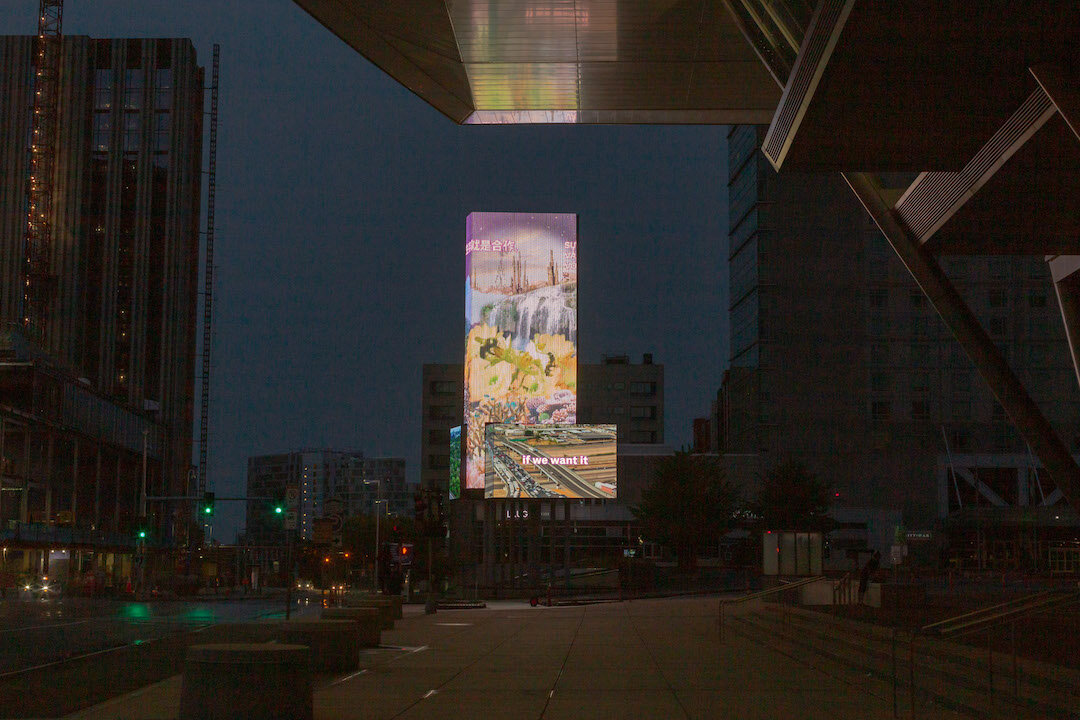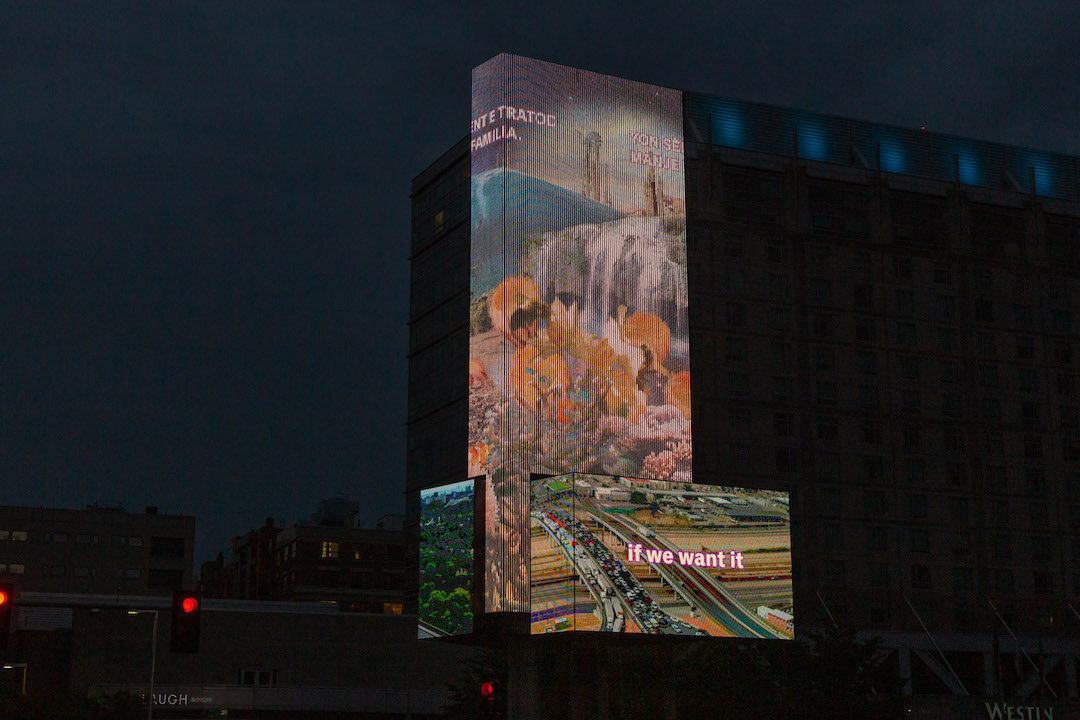︎︎︎
if we want it
In popular U.S. media, “survival” often means winning at the expense of others, whether that be other humans, non-humans, collectives, or worlds. This drive to conquer and colonize echoes Western philosophers during the Enlightenment who framed Nature as something for Man to tame and master. Desires to administer our planet at scale have resulted in pollution, mass extinction, displacement, and climate change, diminishing our very likelihood of survival.
In this work titled if we want it, we share Anna Lowenhaupt Tsing’s framing of survival as collaboration. Tsing writes: “... staying alive—for every species—requires livable collaborations. Collaboration means working across difference, which leads to contamination” (2016). In this spirit, the piece collages together examples of symbiosis: a polyculture farm, coral reef ecosystem, impala and red-billed oxpecker, surfer and ocean.
Formally, we are inspired by Yoko Ono and John Lennon’s WAR IS OVER (if you want it) billboard campaign (1969), in which they aimed to commodify and sell peace, co-opting the language of politicians, companies, and celebrities (fig. 1). At the top of our piece, a running marquee advertises “Survival is collaboration,” in the 6 most common languages of Boston Public Schools: English, Spanish, Haitian Creole, Cape Verdean Creole, Cantonese, and Vietnamese. Each translator works their own meaning into this phrase (“Everyone is treated like family.” / “You can’t do it alone.” / “Life engages in cooperation with the earth.”), sometimes consulting parents or friends. Through this process, translations become an exercise in drawing worlds together. In contrast, we write “if we want it” only in English, the top global business language ranked by the International Monetary Fund in 2018, to question who is included and excluded in the “we” in regards to influence and major decisions affecting our survival.
By Melissa Q. Teng and Sopheak Sam
06.24.2020–10.01.2020
Featured in 31st Round of Art on the Marquee (Summer 2020), curated by Boston CyberArts/George Fifield
![Figure 1: ‘War Is Over! If You Want It’ (1969) photographed by William Sauro, New York Times]()
Source Credits
“CLOWNFISH and Anemone,” 2018. Ocean Pictures, YouTube. Lukasz Szlachta 2017/2018. License CC-BY-SA 3.0 Unported.
“THE ULTIMATE LIGHTNING STORM - In Slow Motion,” 2017. Pecos Hank, YouTube.
“Image of Messier 78 captured with a telescope at the La Silla Observatory.” Photo. European Southern Observatory (ESO)/Igor Chekalin, 2011. License CC-BY 4.0 International.
“Xerophytes: Cardón cacti in the Baja California Desert, Cataviña region, Mexico.” Photo. Tomas Castelazo, 2003. License CC-BY-SA 2.5 Generic.
“Madagascar well.” Photo. Anlace at the English language Wikipedia, 2006. License CC-BY-SA 3.0 Unported.
“Bear predation on salmon can be high in many Alaskan rivers.” Photo. Mark Wipfli, Alaska Cooperative Fish and Wildlife Research Unit, 2006. Public domain.
“Slo-Mo Footage of a Bumble Bee Dislodging Pollen,” 2016. Smithsonian Channel, YouTube.
“A variety of corals form an outcrop on Flynn Reef, part of the Great Barrier Reef near Cairns, Queensland, Australia.” Photo. Toby Hudson, 2010. License CC-BY-SA 3.0 Unported.
“Fishes Near Coral Reef.” Photo. Francesco Ungaro, 2019. Public Domain.
“Jungle Waterfall - mindfulness, ambience, relaxing, meditation, nature,” 2018. Relaxation Windows 4K Nature, YouTube.
“Grass blowing in the wind,” 2009. NigelIsNotAsMadAsYou, YouTube. Creative Commons Attribution license (reuse allowed).
“City Trees and Clouds with clean wind sound effect,” 2018. Time Lapse, YouTube. Creative Commons Attribution license (reuse allowed).
“Amanita muscaria.” Photo. Onderwijsgek [Wiki user], 2012. License CC-BY-SA 3.0 Netherlands.
Mushroom Photo. Unknown photographer [pxhere.com], 2017 [uploaded]. Public Domain.
“A garbage heap in Dar es Salaam, Tanzania.” Jacques Nkinzingabo for The New York Times.
“BIG WAVE SURFING COMPILATION,” 2017. Absolutely Flawless, YouTube.
“Farm areas just outside Chainpur, Bajhang District, Nepal.” Photo. Jason Houston for USAID, 2017. Public Domain.
“Female Impala (Aepyceros melampus) with red-billed oxpecker (Buphagus erythrorhynchus), Kruger National Park, South Africa.” Photo. Diego Delso, 2018, delso.photo, License CC-BY-SA.
“Reed warbler raising the young of a common cuckoo.” Photo. Per Harald Olsen, 2007. License CC-BY-SA 3.0 Unported.scription
if we want it
Collaboration with Melissa Q. Teng, with linh-phương vũ, Lucky Li / 李乐言, Luisina Pozzo Ardizzi, Melice Lopes, Sybille Gorneille
In popular U.S. media, “survival” often means winning at the expense of others, whether that be other humans, non-humans, collectives, or worlds. This drive to conquer and colonize echoes Western philosophers during the Enlightenment who framed Nature as something for Man to tame and master. Desires to administer our planet at scale have resulted in pollution, mass extinction, displacement, and climate change, diminishing our very likelihood of survival.
In this work titled if we want it, we share Anna Lowenhaupt Tsing’s framing of survival as collaboration. Tsing writes: “... staying alive—for every species—requires livable collaborations. Collaboration means working across difference, which leads to contamination” (2016). In this spirit, the piece collages together examples of symbiosis: a polyculture farm, coral reef ecosystem, impala and red-billed oxpecker, surfer and ocean.
Formally, we are inspired by Yoko Ono and John Lennon’s WAR IS OVER (if you want it) billboard campaign (1969), in which they aimed to commodify and sell peace, co-opting the language of politicians, companies, and celebrities (fig. 1). At the top of our piece, a running marquee advertises “Survival is collaboration,” in the 6 most common languages of Boston Public Schools: English, Spanish, Haitian Creole, Cape Verdean Creole, Cantonese, and Vietnamese. Each translator works their own meaning into this phrase (“Everyone is treated like family.” / “You can’t do it alone.” / “Life engages in cooperation with the earth.”), sometimes consulting parents or friends. Through this process, translations become an exercise in drawing worlds together. In contrast, we write “if we want it” only in English, the top global business language ranked by the International Monetary Fund in 2018, to question who is included and excluded in the “we” in regards to influence and major decisions affecting our survival.
By Melissa Q. Teng and Sopheak Sam
06.24.2020–10.01.2020
Featured in 31st Round of Art on the Marquee (Summer 2020), curated by Boston CyberArts/George Fifield

Source Credits
“CLOWNFISH and Anemone,” 2018. Ocean Pictures, YouTube. Lukasz Szlachta 2017/2018. License CC-BY-SA 3.0 Unported.
“THE ULTIMATE LIGHTNING STORM - In Slow Motion,” 2017. Pecos Hank, YouTube.
“Image of Messier 78 captured with a telescope at the La Silla Observatory.” Photo. European Southern Observatory (ESO)/Igor Chekalin, 2011. License CC-BY 4.0 International.
“Xerophytes: Cardón cacti in the Baja California Desert, Cataviña region, Mexico.” Photo. Tomas Castelazo, 2003. License CC-BY-SA 2.5 Generic.
“Madagascar well.” Photo. Anlace at the English language Wikipedia, 2006. License CC-BY-SA 3.0 Unported.
“Bear predation on salmon can be high in many Alaskan rivers.” Photo. Mark Wipfli, Alaska Cooperative Fish and Wildlife Research Unit, 2006. Public domain.
“Slo-Mo Footage of a Bumble Bee Dislodging Pollen,” 2016. Smithsonian Channel, YouTube.
“A variety of corals form an outcrop on Flynn Reef, part of the Great Barrier Reef near Cairns, Queensland, Australia.” Photo. Toby Hudson, 2010. License CC-BY-SA 3.0 Unported.
“Fishes Near Coral Reef.” Photo. Francesco Ungaro, 2019. Public Domain.
“Jungle Waterfall - mindfulness, ambience, relaxing, meditation, nature,” 2018. Relaxation Windows 4K Nature, YouTube.
“Grass blowing in the wind,” 2009. NigelIsNotAsMadAsYou, YouTube. Creative Commons Attribution license (reuse allowed).
“City Trees and Clouds with clean wind sound effect,” 2018. Time Lapse, YouTube. Creative Commons Attribution license (reuse allowed).
“Amanita muscaria.” Photo. Onderwijsgek [Wiki user], 2012. License CC-BY-SA 3.0 Netherlands.
Mushroom Photo. Unknown photographer [pxhere.com], 2017 [uploaded]. Public Domain.
“A garbage heap in Dar es Salaam, Tanzania.” Jacques Nkinzingabo for The New York Times.
“BIG WAVE SURFING COMPILATION,” 2017. Absolutely Flawless, YouTube.
“Farm areas just outside Chainpur, Bajhang District, Nepal.” Photo. Jason Houston for USAID, 2017. Public Domain.
“Female Impala (Aepyceros melampus) with red-billed oxpecker (Buphagus erythrorhynchus), Kruger National Park, South Africa.” Photo. Diego Delso, 2018, delso.photo, License CC-BY-SA.
“Reed warbler raising the young of a common cuckoo.” Photo. Per Harald Olsen, 2007. License CC-BY-SA 3.0 Unported.scription
if we want it, 2020. Installation view, Art on the Marquee (31st Round; curated by Boston CyberArts), Boston Convention and Exhibition Center. Photo by Mel Taing. © Melissa Teng/Sopheak Sam
![if we want it, 2020. Installation view, Art on the Marquee (31st Round; curated by Boston CyberArts), Boston Convention and Exhibition Center. Photo by Mel Taing. © Melissa Teng/Sopheak Sam]()
![if we want it, 2020. Installation view, Art on the Marquee (31st Round; curated by Boston CyberArts), Boston Convention and Exhibition Center. Photo by Mel Taing. © Melissa Teng/Sopheak Sam]()

